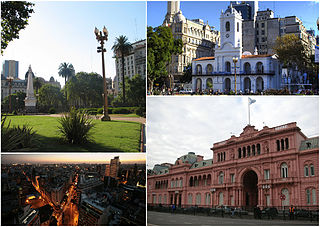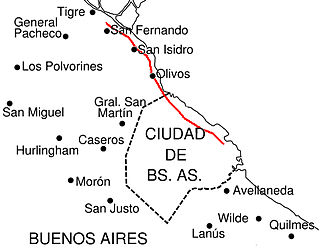This article needs additional citations for verification .(May 2014) |


Thirst (1914).
Callao Avenue (Spanish : Avenida Callao) is one of the principal thoroughfares in Buenos Aires, Argentina.
This article needs additional citations for verification .(May 2014) |


Callao Avenue (Spanish : Avenida Callao) is one of the principal thoroughfares in Buenos Aires, Argentina.
Mayor Torcuato de Alvear, inspired by the urban redevelopment works in Paris at the direction of Baron Haussmann, drew up master plans for major boulevards, running east to west (every six blocks) and north to south (every ten blocks). Named in honor of the decisive Battle of Callao, the avenue was included in the plan and widened in the 1880s. A one-way thoroughfare following a 1967 ordinance, the avenue travels northwards from its outset at Rivadavia Avenue, along the northwest corner of Congressional Plaza. That intersection is known for both the Argentine Congress and the El Molino Café, both of whose domes are Buenos Aires landmarks. At the corner of Callao and Bartolemo Mitre is Residencia Azul, a student residence for college students and foreign travelers.

Three blocks north, the avenue passes by the Bauen Hotel, a modernist highrise that garnered international attention following an employee takeover in the aftermath of its 2001 closure. The hotel, which maintains its 1970s interiors, is today one of Argentina's most successful "recovered workplaces." Two blocks on, Callao is graced by the Church of the Savior, a Jesuit temple designed by local architect Pedro Luzetti between 1872 and 1887; their College of the Savior is adjacent to the church. At Córdoba Avenue, where the avenue enters the upscale Recoleta borough, the Clásica y Moderna bookstore has been one of the avenue's best-known cultural landmarks since 1938, when it became the first in Buenos Aires to incorporate a café. [1] A block on, Rodríguez Peña Plaza provides needed parkland space along one of the city's most-densely populated areas. The plaza is notable for the Pizzurno Palace facing it (the Ministry of Education) and Luisa Isella de Motteau's Thirst, her realist sculpture completed in 1914. A distinctly rounded Art Deco apartment building designed by Francisco Salamone stands on the southwest corner of the avenue and Pacheco de Melo Street. [2]
Callao Avenue ends at Avenida del Libertador, one of the city's most important boulevards. An amusement park, Italpark , stood at this site between 1960 and 1990, after which the lot was converted to Thays Park (named in honor of French Argentine urbanist Charles Thays). The twenty-block avenue is not only a commuter artery, it also features a concentration of belle époque architecture, much of which has been lost to development since the 1950s. The City Legislature is considering assigning a Historical Protection designation on the avenue, a measure protecting 85 significant buildings along Callao. [3]

Florida Street is a popular shopping street in Downtown Buenos Aires, Argentina. A pedestrian street since 1971, some stretches have been pedestrianized since 1913.

Belgrano is a northern and leafy barrio or neighborhood of Buenos Aires, Argentina.

Balvanera is a barrio or neighborhood of Buenos Aires, Argentina.

Recoleta is a barrio or neighborhood of Buenos Aires, Argentina, located in the northern part of the city, by the Río de la Plata. The area is perhaps best known to be the home of the distinguished Recoleta Cemetery. It is a traditional upper-class and conservative neighborhood with some of the priciest real estate in the city, known for Paris-style townhouses, lavish former palaces and posh boutiques.
Avenida Corrientes is one of the principal thoroughfares of the Argentine capital of Buenos Aires. The street is intimately tied to the tango and the porteño sense of identity. Like the parallel avenues Santa Fe, Córdoba, and San Juan, it takes its name from one of the Provinces of Argentina.

May Avenue is an avenue in Buenos Aires, capital of Argentina. It connects the Plaza de Mayo with Congressional Plaza, and extends 1.5 km (0.93 mi) in a west–east direction before merging into Rivadavia Avenue.

According to the World Travel & Tourism Council (WTTC) the travel and tourism sector of Argentina was moving towards recovering its pre-covid pandemic contribution to GDP in mid-2023, led by Buenos Aires.

Avenida Alvear is an upscale thoroughfare in Buenos Aires, Argentina. Located in the neighbourhood of Recoleta, it extends for seven blocks, from the Plazoleta Carlos Pellegrini to Alvear Plaza. The avenue is famous not only for the most exclusive representatives of haute couture, but also for its numerous demi-palaces and extensive presence of the French academy architecture that was so much in vogue in uptown Buenos Aires at the turn of the 20th century. The Buenos Aires Legislature approved the bill to declare it as a Historic Protection Area. A study by the U.S. television network NBC, placed it among the world's five most distinguished avenues.

Monserrat or Montserrat is a neighbourhood in the east of the Buenos Aires CBD. The district features some of the most important public buildings in Buenos Aires, including city hall, the city legislature, Casa Rosada, the Colegio Nacional de Buenos Aires and the Libertador Building, among others.

Avenida Rivadavia is one of the principal thoroughfares in Buenos Aires, Argentina, extending 23 miles (37 km) from downtown Buenos Aires to the western suburb of Merlo. It is considered the third longest avenue in the world after Yonge Street (Toronto) and Western Avenue (Chicago).

Avenida del Libertador is one of the principal thoroughfares in Buenos Aires, Argentina, and in points north, extending 25 km (16 mi) from the Retiro District of Buenos Aires to the northern suburb of San Fernando.

Avenida Santa Fe is one of the principal thoroughfares in Buenos Aires, Argentina. The artery is essential to the imaginary axis of Barrio Norte in Buenos Aires, comprising the areas influenced by the route of the avenue through Retiro, Recoleta and Palermo neighborhoods, it is considered one of the main shopping and strolling areas of the city, its many boutiques range from elegant to edgy, which has led it to be dubbed the 'Avenue of Fashion'. Upscale Alto Palermo, at Avenida Coronel Díaz, is one of the city's best-known vertical malls. Avenida Santa Fe is also an attraction for its architecture, strongly reminiscent of Paris. Its name pays homage to the eponymous province in Argentina.

Avenida Figueroa Alcorta is a major thoroughfare in Buenos Aires, Argentina, with a length of over 7 km (4.3 mi) along the city's northside.

Córdoba Avenue is one of the principal thoroughfares in Buenos Aires, Argentina.

Avenida Leandro N. Alem is one of the principal thoroughfares in Buenos Aires, Argentina, and a commercial nerve center of the city's San Nicolás and Retiro districts. It joins Avenida del Libertador and Avenida Paseo Colón, its northern and southern continuation respectively.

The Italpark was a theme park in Argentina, which was located where currently is the Parque Thays in the Recoleta neighbourhood of Buenos Aires. It became a landmark of Buenos Aires in its 30 years of existence.

The Monumento ecuestre a Carlos María de Alvear located on Plaza Julio de Caro, a landmark in the Recoleta neighbourhood of Buenos Aires, Argentina, and was raised in honor of Carlos María de Alvear (1788-1852).

The Parque Thays is a public space in Recoleta, Buenos Aires, Argentina. The park is located in the corners of Libertador avenue y Callao avenue.

Avenida General Sarmiento is an avenue located in the Palermo neighborhood, in Buenos Aires, Argentina. It runs from Plaza Italia to the Costanera Rafael Obligado Avenue, across the Parque Tres de Febrero.

Plaza Francia is a public square in the barrio of Recoleta in Buenos Aires, Argentina. The nearby Plaza Intendente Alvear is commonly but mistakenly known by the same name. It was created by a Municipal Ordinance on October 19, 1909, as part of the changes introduced in the urban landscape on the occasion of the Argentina Centennial. Designed by French landscape architecture Carlos Thays, it is part of a broad set of squares including Plaza Intendente Alvear, Plaza San Martín de Tours, Plaza Juan XXIII, Plaza Ramón J. Cárcano, Plaza Dante and Plaza Rubén Darío, among others.